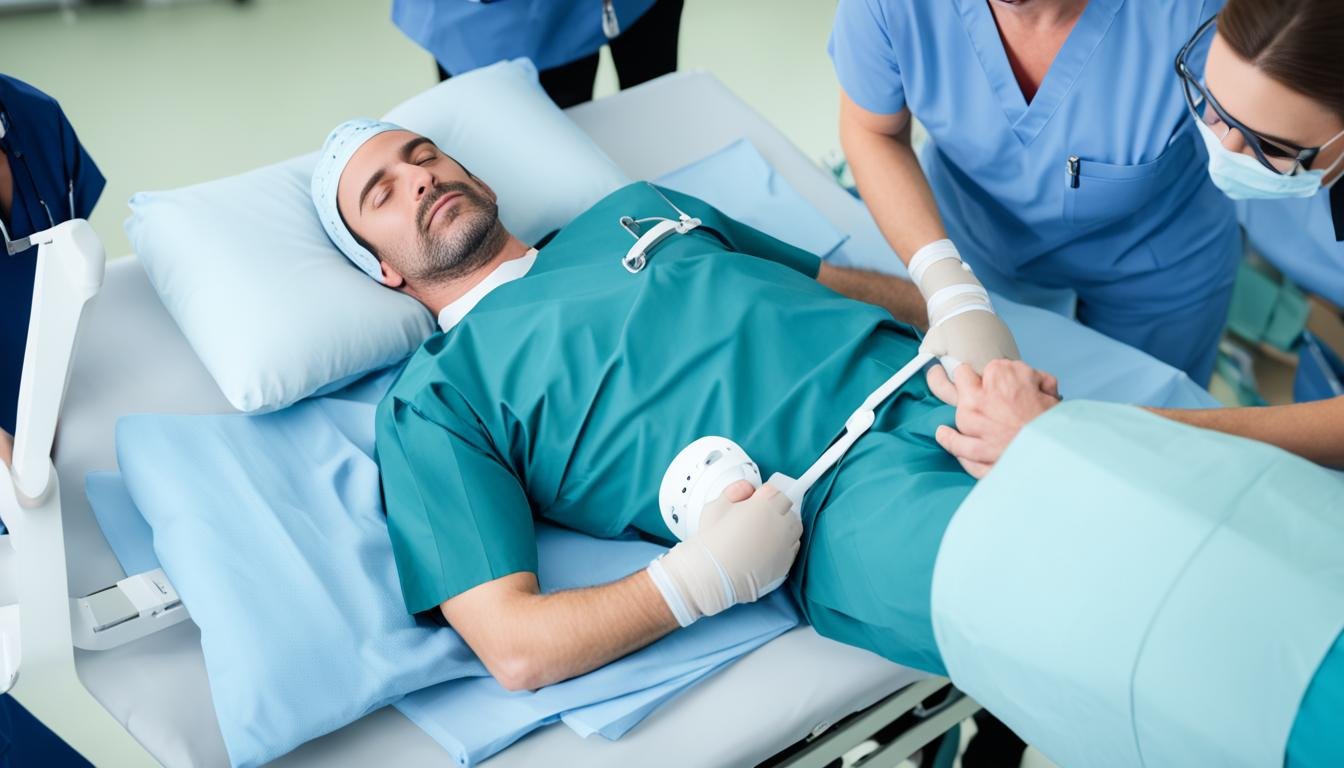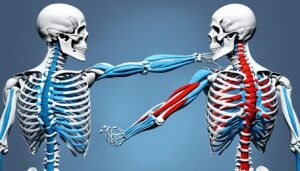Total knee replacements are becoming more common each year. They’re often done because of osteoarthritis and rheumatoid arthritis.1 While knee replacements help with knee pain, they might cause back and hip pain. This happens because the back and hip nerves are linked to the knees. If these nerves get bothered, it can cause pain in the back and hips. Things like walking differently and having different muscle strengths after surgery can also make back pain worse.1 Knowing these common reasons can help find the right treatment for back pain after knee surgery.
Key Takeaways
- Knee replacement surgery can sometimes lead to back pain due to nerve irritation, gait changes, and muscle imbalances.
- A combination of conservative treatments, physical therapy, and lifestyle modifications can effectively relieve back pain after knee surgery.
- Spinal decompression therapy can help reduce pressure on the discs and nerves, providing pain relief.
- Proper posture and body mechanics are crucial for a successful recovery and minimizing back pain.
- Seeking medical attention for persistent or worsening back pain is important to address any underlying issues.
Common Causes of Back Pain After Knee Surgery
After getting a new knee, changing how you walk can cause back pain.2 This is because your body needs to adjust. This may lead to pain and swelling in other areas.2 If you had osteoarthritis before surgery, you might still have back pain.2
Gait Changes and Muscle Imbalances
Getting a knee replacement can mess with your gait. This can hurt your muscles and joints, even in your back.2 Doing physical therapy after surgery helps fix this.2
Preexisting Osteoarthritis
Osteoarthritis often leads to knee surgery. But, it can also cause hip and back pain.2
Nerve Irritation During Surgery
Sometimes, surgery can irritate or inflame nerves. This can make pain spread to your back and hips.2 Damage or an infection in your nerves can also keep your back and hips hurting.2
Know the main reasons for back pain after knee surgery. This helps make a good plan to treat it.
Conservative Treatments for Back Pain Relief
After knee surgery, simple steps like rest and elevation can help back pain a lot. Use ice packs and compression.3 This makes blood flow better and stops swelling. It also soothes the pain.4
Rest and Elevation
Let your back rest and raise your leg. This eases discomfort and speeds healing after surgery. It boosts blood flow and cuts swelling.4
Ice Packs and Compression
Cold packs and wrapping the area also ease back pain. Ice shrinks blood vessels and lessens swelling. Wrapping it up keeps things steady, stopping extra pain.4
Pain Medication Management
You can try drugs like acetaminophen or NSAIDs for the pain.4 But always do what the doctor says. Be careful with strong pain pills. They can be habit-forming.4
Role of Physical Therapy in Knee Replacement Recovery
Physical therapy is key after knee surgery. It starts before the operation, with prehabilitation. This step gets your muscles ready. It helps you lose less muscle and have a better surgery outcome.5
Post-operative Rehabilitation
After surgery, the focus is on getting movement, strength, and flexibility back. It also helps fix muscle and walking problems.5 Physical therapists fix movements that can cause back pain. This makes your recovery easier and more comfortable.5
Addressing Muscle Imbalances and Gait Issues
After knee surgery, your walking and muscle balance might be off. This can cause back pain.5 Physical therapists are vital in getting things back in balance. They make sure your body moves right. This stops strain on your back.5 You’ll feel better and recover well with their help.5

Physical therapy is crucial in getting you back on track. It’s vital for strength, flexibility, and the right way to walk.5 Therapists use proven exercises to help. They make sure you manage and lessen back pain after surgery.56
Spinal Decompression Therapy for Back Pain Relief
Spinal decompression therapy is a gentle way to help back pain without surgery. A special table stretches the spine softly.7 This helps ease the pressure on the discs and nerves, making it great for people with back pain after knee surgery. It boosts healing and lessens pain by reducing disc pressure.7 It’s wise to see a health expert who knows about spinal decompression, especially after big surgeries like knee replacements.
Understanding Spinal Decompression
This therapy lessens spine pressure, helps healing, and allows nutrients to fix damaged spots.7 It’s good for various spinal probs like sciatica. Many feel better after just a few sessions.7
Benefits of Spinal Decompression After Knee Surgery
Back pain can majorly change how you live, even affecting your feelings.7 This treatment isn’t surgery. It helps heal the pain source.7 By boosting blood flow to the spine, it helps healing after knee surgery.7
Considerations for Spinal Decompression After Knee Replacement
Spinal decompression is good for many back issues and helps right away.8 It makes daily life more comfy.8 You might move and bend better since it reduces pressure on your spine.8
It’s a less severe choice than drugs, therapy, or surgery, cutting down on risks and recovery time.8 It aims for long-lasting pain relief by fixing spinal problems directly. This also helps with healing.8 Common effects are just slight discomfort, muscle twists, and temporary aches. These go away fast and the treatment helps a lot.8
Before you start, see an expert in bone health for the right diagnosis and plan.8
how to relieve back pain after knee surgery?
Dealing with back pain after knee surgery? You can tackle this in many ways. Start with simple things like rest and applying ice. Over-the-counter pain pills can help too.2
Physical therapy is key. It fixes muscle imbalances and helps you walk better. It also builds back your strength and flexibility.2
Spinal decompression therapy is another good choice. It eases pressure on your discs and nerves. This makes it easier to move and cuts down on pain.2
Changing up your daily life can make a big difference too. Eat healthy, skip alcohol and smoking, and find ways to reduce stress. This all speeds up your healing.2
In the future, more people will get total knee replacements. This is often due to arthritis and knee injuries.2
After a knee replacement, you might feel pain in your back and hips. This is because the nerves are linked.2
Your walking pattern may change, leading to this pain. But don’t worry, physical therapy can really help.2
Knee arthritis is a big reason people get replacements. It can also cause back and hip pain.2
Sometimes, the nerves get irritated after surgery. This can make your back and hips hurt too.2
To help with this pain, rest and use ice. Elevation and wearing compression bands can also work. Pain meds and physical therapy are important.2
Doing physical therapy before and after surgery is very beneficial. It builds your muscles and speeds up your recovery.2
Managing pain after surgery is very important.9
Following your physical therapy plan is crucial for less swelling and pain. Remember, doing your exercises daily is key.9
They might give you painkillers, but be careful not to use them for too long.9
Using cold packs helps with the pain and swelling. Just make sure to use them the right way.9
Try to get moving as soon as possible. It helps with the swelling and makes you feel better.9
Knee surgery is a big help for people in pain.10
After you heal, most adults can move better and do regular activities.10
You may feel pain and see swelling for a few months. This is more at night or when you’re active.10
Usually, you can go back to daily life with less hurt in three to six weeks.10
It can take up to a year to fully heal from knee surgery.10
Physical therapy helps you get back movement and strength in your knee.10
At first, you might need strong pain medicine.10
Exercising gently in your therapy can reduce pain.10
It’s normal for your knee to feel a little swollen for up to six months.10
Watch out for signs like blood clots or infection after surgery.10
If you have trouble breathing, bad chest pain, or other bad signs, tell your doctor right away.10
Knee Replacement Surgery: An Overview
Knee replacement surgery is called knee arthroplasty. It’s done to ease pain and make knees work better. These knees are very damaged from things like osteoarthritis or rheumatoid arthritis.2 This surgery uses fake parts that are metal and plastic.11
Common Indications for Knee Replacement
Knee surgeries help with arthritis pain, often from severe joint damage.11 They are common for those with osteoarthritis, rheumatoid arthritis, or bad knee injuries.2
Candidates for Knee Replacement Surgery
People suitable for this surgery are usually 50 to 80. They’ve tried many other treatments that didn’t work. They find it hard to do daily tasks because their knees hurt and are stiff.2
Posture and Body Mechanics After Knee Surgery
After knee surgery, people might start walking funny or need a cane.12 This happens because their knee now works differently. It puts more stress on their lower back and can cause pain and trouble.12 Doing this for a while can mess up their balance. This makes the problem worse.13
Compensatory Movements and Their Impact
How people walk changes a lot after knee surgery.12 They may limp or start leaning on one side more. This can make one side of their body stronger than the other.13 It also puts more pressure on their back. This leads to back pain. It’s hard for them to get better and move around normally again.
Correcting Postural Misalignments
To fix back pain due to walking changes, seeing a physical therapist is key.12 They teach people how to move right again. They also fix any muscle or movement problems. This helps people stand and move better.13 It takes away the back pain and helps them heal well after surgery.
Doing physical therapy exercises and getting the right support help a lot.12 It’s a full plan to get things back in line. It makes muscles work better and takes pressure off the back. This way, healing is smoother and not as painful.13
Lifestyle Modifications for Faster Recovery
Making lifestyle changes can speed up your recovery after knee surgery.14 Eating right helps your bones and muscles heal faster.14 It’s crucial to skip alcohol and smoking.15 These slow your healing and make complications more likely.15
Adopting a Nutritious Diet
A healthy, balanced diet is key to recovering well from knee surgery.14 Foods high in protein, vitamins, and minerals are great for healing.14 Caregivers and doctors should talk about what the patient needs to eat. This way, they’ll get better soon.
Avoiding Alcohol and Smoking
Stopping alcohol and smoking is crucial for getting better from knee surgery.15 They slow down your natural healing and raise risks.15 Working with the hospital team on this can help. They’ll support your new healthy choices.
Good food, no alcohol, and no smoking help you heal faster.141516 This, plus medical care and exercising, makes your recovery smoother. It also lowers your chances of having back pain or other problems later.141516
Pain Management Options After Knee Surgery
After a knee operation, handling pain is key to getting better. Meds like acetaminophen and NSAIDs really help at first.1 Doctors use a 0 to 10 scale to see how much pain you’re in.1
Prescription Opioids and Non-opioid Analgesics
Doctors might also give prescription painkillers. But, it’s critical to take these drugs only as your doctor says, and for a short time.17 Every day, over 130 people in the U.S. die from an opioid overdose.17 And, remember, don’t take more than 4,000 mg of acetaminophen in 24 hours.17
Consulting a Pain Management Specialist
Talking to a pain expert can lead to the best plan for your pain. They’ll think about your health, how you’re feeling now, and what you like.18 A pain doctor’s advice and care are crucial for dealing with pain after surgery.18
1 Always let your doctor know if certain pain meds don’t agree with you or if you drink a lot. Also, tell your doctor what has helped you feel better in the past.1 Often, opioids are used right after surgery for quick pain relief. But the goal is to switch to other pain meds as soon as you can.1
17 If you have any leftover opioids, get rid of them the right way. You can find out how on the government websites of Minnesota and Wisconsin.17 It’s a good idea to use less and less opioid as you find other ways to manage your pain.17
17 Some pain pills might upset your stomach, so eat something when you take them.17 Remember, managing your pain happens even after you leave the hospital. There are many videos to help you learn how to do this at home.17
1 Aromatherapy can help ease pain and stress.1 Walking is good for reducing pain and helping you avoid issues like pneumonia.1 Massage, especially gentle types, can make you feel better.1 Cold packs can also help with pain and swelling.1 Rest is very important to heal.1 Moving in bed every two hours can lessen your pain.1 Techniques to relax can make you feel less stressed as you get better.1
18 The information talks about big knee operations like ACL and meniscus repairs, and replacements. It shows how common these surgeries are and how experts deal with pain after.18 For pain, sometimes doctors inject medicine near a nerve, which can really help.18 Many options are out there to help with pain, from medicines to using ice packs. This shows that there are different ways you can manage your pain.18 After surgery, it’s important to eat well, quit smoking and watch how much alcohol you drink. This is all part of getting better.18 Doing low-impact exercises like walking helps you heal faster. It’s important to stay active for your recovery.18
Ergonomic Support Aids for Back Pain Relief
Using ergonomic support aids is great for reducing back pain after knee replacement surgery.19 Many workers have lower back pain every year. Sitting for long times can stress the back, neck, arms, and legs. It weakens our core muscles and increases the body’s resistance to insulin.20 To fight back pain from bad posture and sitting a lot, ergonomic tools are really important. They help keep our neck and back safe, especially if we work at a desk.
Lumbar pillows, back braces, and furniture you can change are really helpful.19 The Vaunn Medical Lumbar Back Support Pillow is excellent – it got a perfect score for comfort, support, quality, and price. The Bonmedico Standard Memory Foam Seat Cushion is also great. It costs $43 and was rated 5/5 for its value. For those with back pain, the Qutool Orthopedic Seat Cushion is a top pick. It was marked 5/5 for comfort and value. If you need extra support, the ComfiLife Gel Enhanced Seat Cushion is a good choice.
19 The Milliard Memory Foam Seat Cushion scored 4.7/5 for quality. It’s great for your spine and easy to breathe on. The TushGuard Seat Cushion helps keep your posture correct. It uses memory foam for extra comfort. If you have pain in your tailbone, try the Purple Royal Seat Cushion. It has a firm gel cushion and comes with a soft jersey cover. The Coushy Ergonomic Back Relief Cushion is another top pick. It’s praised for being comfy and of great quality. Plus, it’s safe for anyone with allergies, being hypoallergenic.
20 Ergonomic items can be a bit costly, but there are cheaper options out there. A good chair should support your head and neck and have a back that you can adjust. It should also let you move and keep your spine’s curve natural. Sit-stand desks are very helpful. They can fight back pain and even help you lose weight by using more energy. If you stand a lot at work, consider a standing desk mat for comfort. It supports your feet. Using a laptop stand helps keep your screen at eye level. This way, you can avoid straining your neck and back. For those who need it, lumbar support cushions are good for your posture and to keep back pain away.
20 There are easy tips to prevent back pain. Adjust your screen to the right height. Sit and stand up straight. Make sure you have enough space for your legs. Use a headset for your phone. Take breaks to stretch if you sit a lot. If your back hurts, it’s best to see a doctor who knows about back problems.
| Product | Original Price Range | Current Price Range | Discount Range |
|---|---|---|---|
| Ergonomic Support Aids | $25.00 – $649.99 | $25.00 – $530.00 | 0% – 60% |
| Ergonomic Office Furniture | $1,073.60 – $8,950.00 | N/A | N/A |
| Zero Gravity Recliners | $2,259.00 – $5,499.00 | N/A | Up to 20% off |
21 Ergonomic support aids vary in price, from $25.00 to $649.99. Now, they cost between $25.00 to $530.00. You can save from 0% to 60% on these items.21 For office furniture that’s good for your health, prices range from $1,073.60 to $8,950.00. Zero gravity recliners, which can also help, are priced from $2,259.00 to $5,499.00. You might even find them on sale, with discounts up to 20% off.
Stress Management Techniques for Pain Coping
After knee replacement surgery, you face physical and emotional obstacles. These hurdles can make back pain worse.22 Stress from surgery and other issues can heighten your pain.22 For example, stress and anxiety may cause your chronic pain to flare up.22 By learning stress management, you can deal with pain better and feel more at ease.
Relaxation Exercises
Relaxation exercises, like deep breathing and gentle yoga, are great. They help with pain and make your recovery more positive.22 Studies show that meditation and deep breathing make your body relax.22 People with chronic pain feel better and are stronger when they use these stress tools.
Mind-Body Practices
Mind-body practices focus on being mindful and taking care of yourself. They can help you manage back pain after surgery.22 Cognitive therapy is one method that can lessen your pain a lot.22 It’s important to keep your body, mind, and emotions in balance for chronic pain care.
When to Seek Medical Attention for Persistent Back Pain
Many times, back pain gets better with simple treatments and changes in life. But, if it doesn’t get better or gets worse, see a doctor.23 Bad back pain, especially with numbness, tingling, or weakness, might mean a big health problem. This needs a doctor’s care.23 Seeing a doctor soon can stop the pain from lasting and help you get better.
23 Got back pain for over a week even after trying things at home? It’s time to get it checked.23 Also, if the pain never stops, is really bad at night, or laying down, see a doctor.23 And, if the pain started right after a bad accident or makes it hard to control your bowel or bladder, go to the ER right away.
23 Feeling weak, numb, or tingly in your legs with back pain? See a doctor.23 Pain spreading down your leg or lots of weight loss with back pain mean it’s time to see a doctor.23 Swelling or redness on your back with pain should also get checked by a healthcare worker.
4 Sometimes, surgery is needed for back pain, especially if you have some warning signs.4 But, surgery for ongoing back pain might not make it go away totally. Talk with your doctor about this.
Conclusion
Recovering after knee surgery can be tough. But, the right steps can help. Start by knowing why back pain happens.24
Use a mix of treatments like physical therapy and changing your lifestyle. These can make you feel better and heal well.2425 Work with your healthcare team too. They can suggest the best ways to deal with back pain. This all helps you get back to enjoying life.
Physical therapy is key for getting better. It helps fix muscle problems and how you move.24 Trying spinal decompression can also ease pain. It takes the pressure off your back. Plus, simple lifestyle changes can speed up your recovery. This includes eating well, not drinking or smoking, and learning how to manage stress.
Recovering might be hard, but you can do it by knowing your options. Get the help you need, and change how you live a bit. Putting your health first and working with your medical team can really help. They’ll work with you to cut back pain and improve your life.
FAQ
What are the common causes of back pain after knee surgery?
How can conservative treatments help relieve back pain after knee surgery?
What role does physical therapy play in recovering from knee replacement surgery?
How can spinal decompression therapy help with back pain after knee replacement?
What are the common indications and candidates for knee replacement surgery?
How can ergonomic support aids help with back pain after knee surgery?
What pain management options are available after knee replacement surgery?
When should someone seek medical attention for persistent back pain after knee surgery?
Source Links
- https://www.allinahealth.org/health-conditions-and-treatments/health-library/patient-education/total-knee-replacement/surgery-and-beyond/how-to-manage-your-pain
- https://www.allianceptp.com/why-am-i-feeling-hip-and-back-pain-after-total-knee-replacement
- https://www.ncbi.nlm.nih.gov/pmc/articles/PMC10324732/
- https://www.hopkinsmedicine.org/health/conditions-and-diseases/back-pain/7-ways-to-treat-chronic-back-pain-without-surgery
- https://www.hss.edu/article_exercises-after-knee-replacement.asp
- https://www.ncbi.nlm.nih.gov/pmc/articles/PMC9277921/
- https://www.orthobethesda.com/blog/spinal-decompression-therapy/
- https://www.ctortho.com/2024/03/15/spinal-decompression-therapy-benefits-and-considerations/
- https://www.drhermanbotero.com/5-tips-for-managing-pain-bruising-and-swelling-after-knee-replacement-surgery/
- https://www.christushealth.org/connect/your-health/orthopedics/pain-after-knee-replacement
- https://www.mayoclinic.org/tests-procedures/knee-replacement/about/pac-20385276
- https://www.proortho.com/spine-body-mechanics/body-mechanics/
- https://www.stjoes.ca/patients-visitors/patient-education/a-e/PD 5844 Resp Rehab – Back Pain and Posture.pdf
- https://www.healthline.com/health/knee-replacement-surgery
- https://www.arthritis.org/diseases/more-about/lifestyle-changes-back-pain
- https://www.virtua.org/articles/7-exercises-to-get-you-back-on-your-feet-after-knee-replacement
- https://www.allinahealth.org/health-conditions-and-treatments/health-library/patient-education/total-knee-replacement/after-surgery/pain-relief
- https://www.texaspainphysicians.com/2021/03/5-ways-to-decrease-the-pain-after-knee-surgery/
- https://www.health.com/best-seat-cushions-for-back-pain-7372974
- https://www.eliteorthopaedic.com/blog/tips-to-prevent-back-pain
- https://relaxtheback.com/
- https://austinpaindoctor.com/coping-mechanisms-chronic-pain
- https://www.mayoclinic.org/symptoms/back-pain/basics/when-to-see-doctor/sym-20050878
- https://www.ncbi.nlm.nih.gov/pmc/articles/PMC6819170/
- https://www.ncbi.nlm.nih.gov/pmc/articles/PMC9891300/




